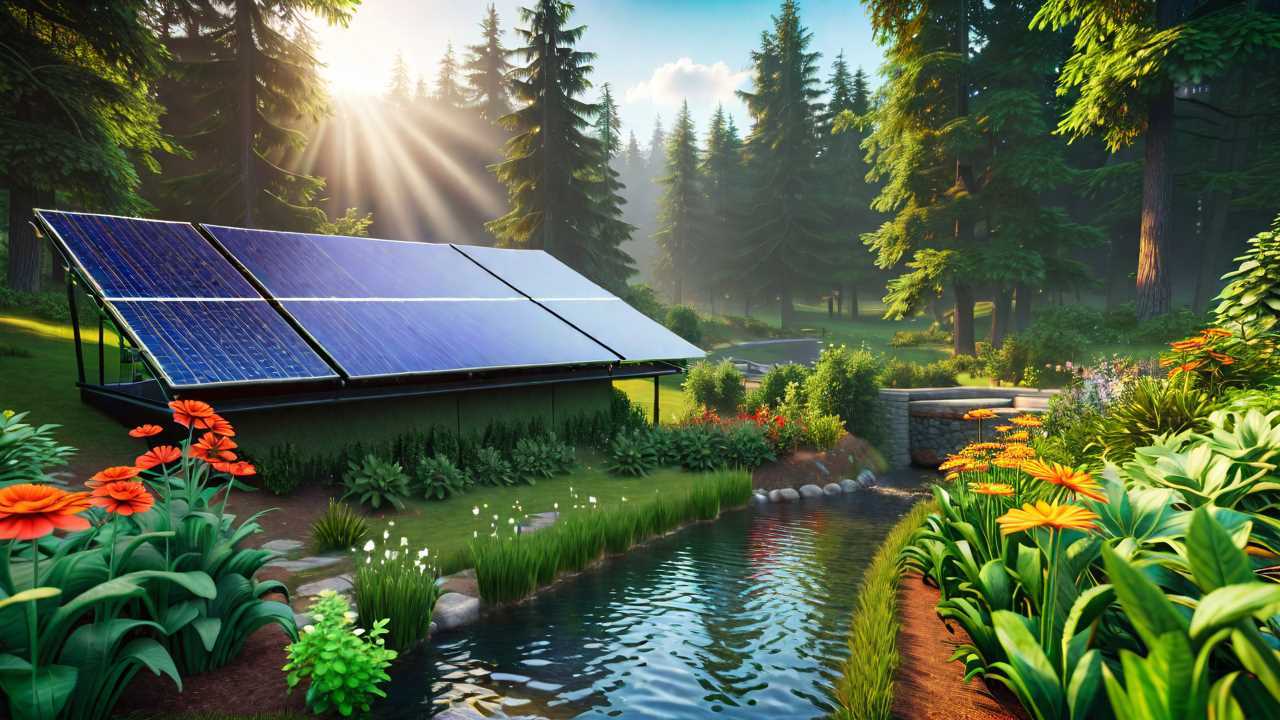
When considering your garden, have you ever thought about utilizing renewable energy sources to boost its sustainability? By integrating solar-powered garden lights and wind turbines, you can lessen your environmental impact and establish a more eco-friendly outdoor space. But there's more to uncover beyond just these options. Stay tuned to discover innovative ways to power your garden while embracing a greener approach that benefits both your plants and the planet.
Solar-Powered Garden Lights
Enhance your garden's ambiance and sustainability by incorporating solar-powered garden lights. These lights are a practical and energy-efficient way to illuminate your outdoor space while reducing your carbon footprint. Solar-powered garden lights harness energy from the sun during the day, storing it in rechargeable batteries to power the lights at night.
To make the most of solar-powered garden lights, make sure they're installed in areas that receive plenty of sunlight throughout the day. This will allow the solar panels to absorb as much energy as possible, guaranteeing your lights shine brightly all night long.
Additionally, opt for high-quality lights with durable construction to withstand the elements and last for years to come.
Not only do solar-powered garden lights help you save on electricity costs, but they also add a charming touch to your garden. From pathway lighting to decorative string lights, there are various styles to suit your garden's aesthetic.
Embrace the beauty of renewable energy with solar-powered garden lights.
Wind Turbines for Energy
Consider incorporating wind turbines into your garden to harness renewable energy efficiently and sustainably. Wind turbines are a great way to generate electricity by utilizing the power of the wind.
When choosing a wind turbine for your garden, make sure to select a model suitable for residential use and compatible with your location's average wind speeds. Placing the wind turbine in an open area free from obstructions will maximize its effectiveness.
To install a wind turbine, secure it on a sturdy tower at an elevation to catch the most wind. It's important to check local regulations and obtain any necessary permits before installation.
Regular maintenance, such as lubricating moving parts and checking for wear and tear, will ensure top-notch performance.
Hydroponic Systems Utilizing Renewable Energy
To improve the sustainability of your garden further, consider incorporating renewable energy sources like solar power to fuel your hydroponic systems efficiently. Hydroponic systems are a great way to grow plants without soil, using mineral nutrient solutions in a water solvent.
By integrating solar panels to power your hydroponic setup, you can reduce your reliance on traditional energy sources and lower your carbon footprint.
Solar-powered hydroponic systems operate by harnessing energy from the sun through solar panels. This energy is then used to power pumps, lights, and other necessary components of your hydroponic garden. By utilizing renewable energy in this way, you can run your hydroponic system more sustainably and cost-effectively.
Additionally, solar power provides a consistent and reliable source of energy, ensuring that your hydroponic plants receive the light and nutrients they need to thrive.
Benefits of Renewable Energy in Gardening
Harnessing renewable energy sources in your gardening practices can lead to numerous benefits for both your garden and the environment. By utilizing solar panels to power garden lights or water features, you can reduce your reliance on traditional energy sources, ultimately lowering your carbon footprint.
Solar-powered irrigation systems can help you efficiently water your plants while saving on electricity costs. Wind turbines can also be integrated into your garden to generate clean energy for running tools or equipment.
Incorporating renewable energy into your gardening routine not only helps you save money in the long run but also contributes to environmental conservation by reducing greenhouse gas emissions. Additionally, using renewable energy sources can increase the overall sustainability of your garden, aligning your practices with eco-friendly principles.
Embracing renewable energy technologies in your gardening endeavors can create a more self-sufficient and environmentally conscious space that benefits both your plants and the planet.
Frequently Asked Questions
What Are the Maintenance Requirements for Solar-Powered Garden Lights?
To maintain solar-powered garden lights, regularly clean the solar panels, make sure they receive direct sunlight, replace rechargeable batteries as needed, and check for any damage. Periodically, inspect the lights for proper functionality and make adjustments accordingly.
How Much Wind Speed Is Needed for a Wind Turbine to Be Effective?
Ever wondered how much wind is needed for a wind turbine to work effectively? Well, typically, a wind speed of around 7-10 meters per second is necessary for peak performance. This guarantees that your turbine generates ample renewable energy.
Can Hydroponic Systems Using Renewable Energy Be Used Indoors and Outdoors?
Yes, hydroponic systems using renewable energy can be used both indoors and outdoors. Solar panels can power indoor setups, while outdoor systems can utilize wind or solar energy. These sustainable options offer efficient growth potential for your plants.
Are There Any Government Incentives for Using Renewable Energy in Gardening?
You can investigate government incentives for renewable energy in gardening. Look into tax credits, rebates, and grants. These incentives can help make your garden more sustainable and environmentally friendly while saving you money.
Can Renewable Energy Systems Store Excess Power for Later Use in the Garden?
Yes, renewable energy systems can store excess power for later use in the garden. Consider utilizing batteries or grid-tie systems with net metering. This way, you can harness and save the energy generated efficiently.
 SportsHollywoodLifestyleFashionHome & GardenTrendsPrivacy PolicyTerms And Conditions
SportsHollywoodLifestyleFashionHome & GardenTrendsPrivacy PolicyTerms And Conditions
